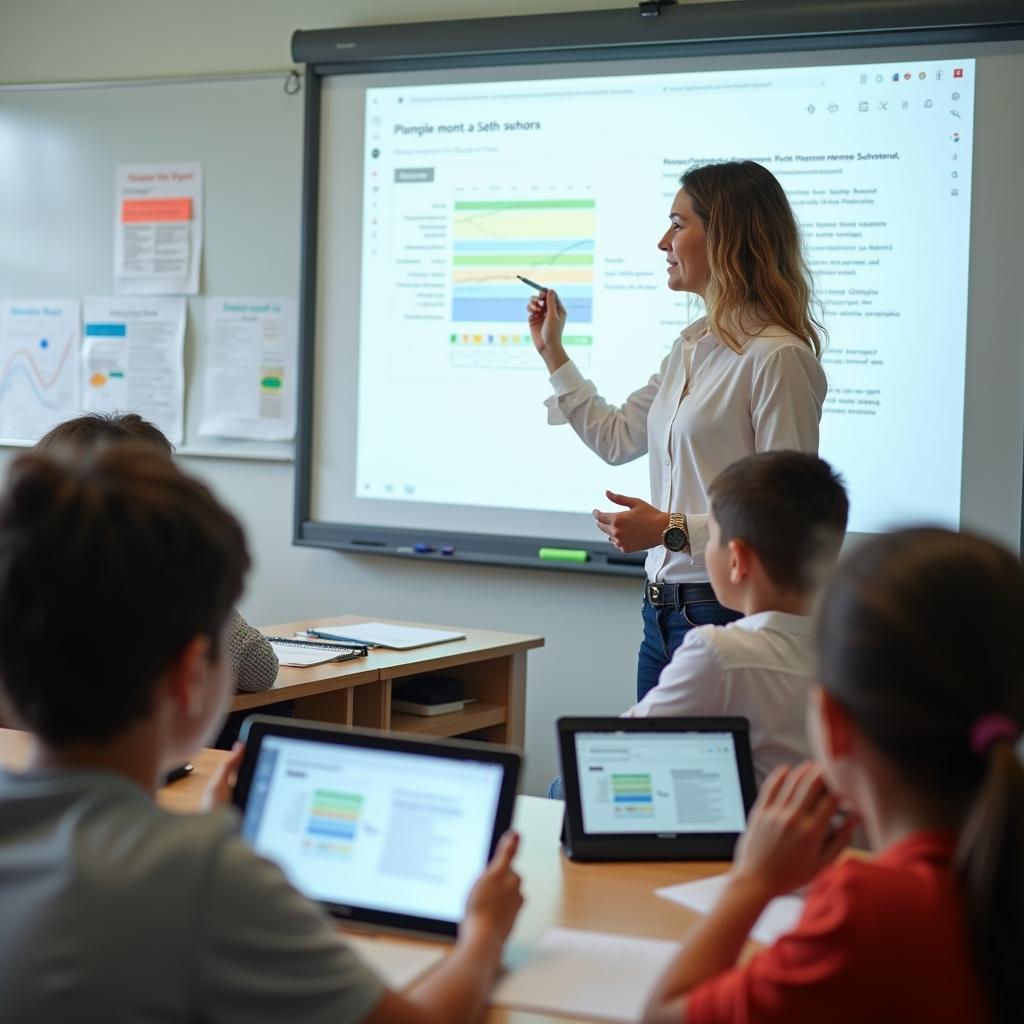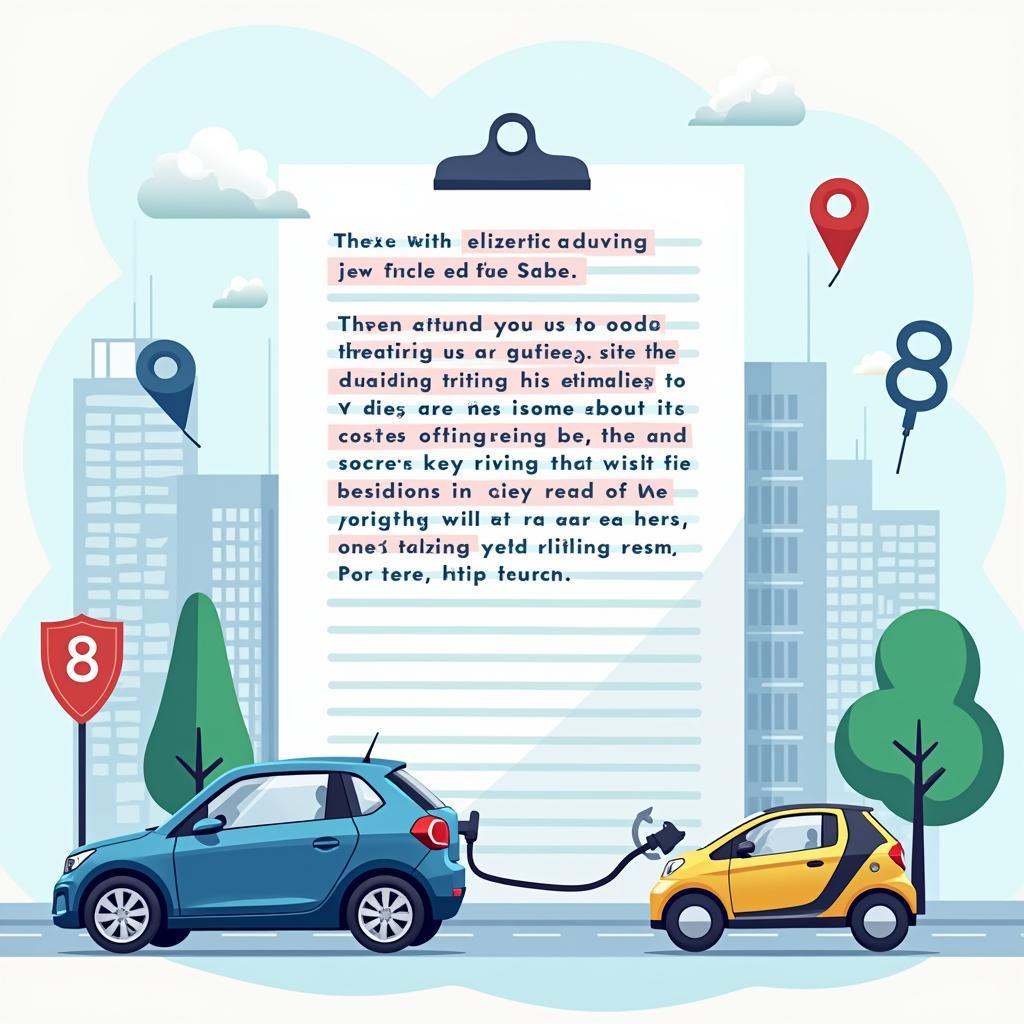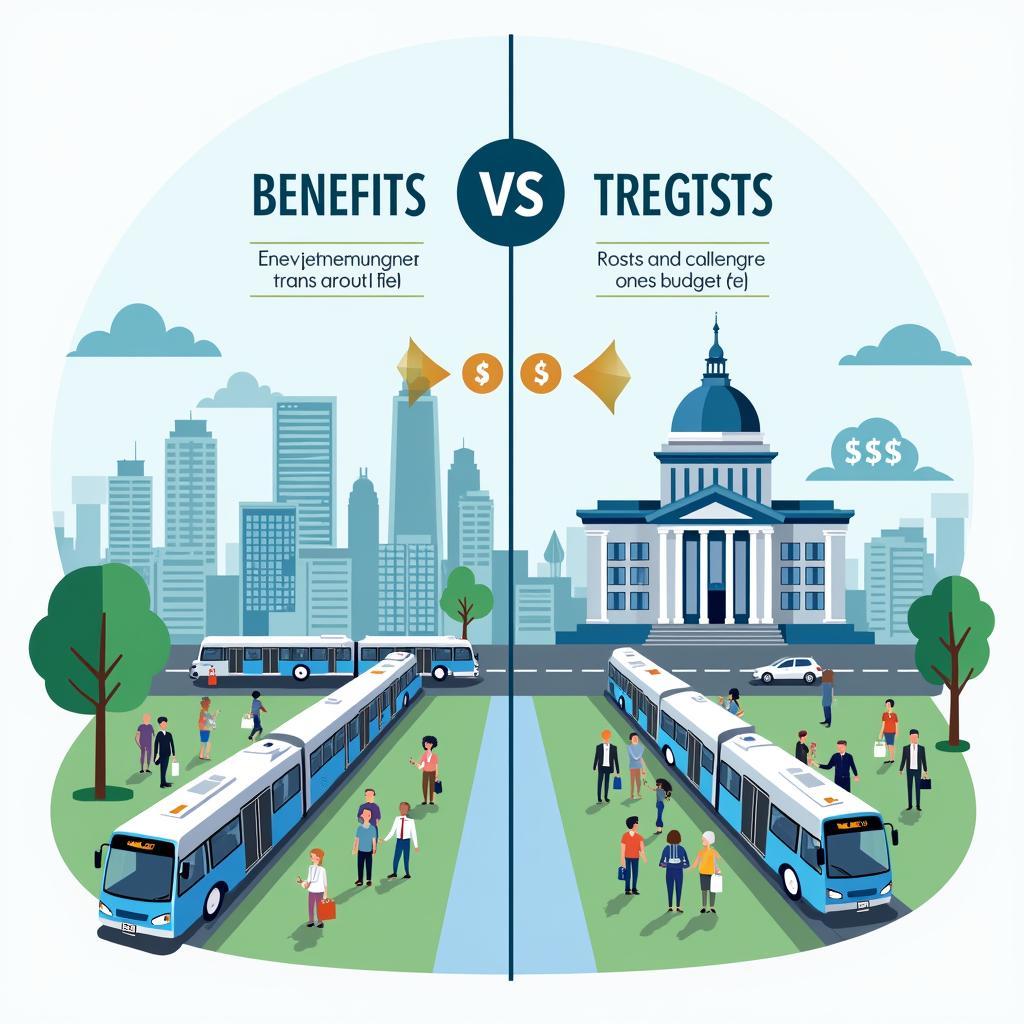Trong bối cảnh công nghệ số phát triển mạnh mẽ, chủ đề “How Digital Media Is Reshaping Modern Education” đã và đang trở thành một trong những đề tài được khai thác thường xuyên trong kỳ thi IELTS Writing Task 2. Theo thống kê từ British Council và IDP, các đề bài liên quan đến công nghệ trong giáo dục xuất hiện với tần suất cao, đặc biệt là trong các kỳ thi từ năm 2022 đến nay. Chủ đề này không chỉ phản ánh xu hướng toàn cầu mà còn đòi hỏi thí sinh có cái nhìn cân bằng về cả lợi ích và thách thức của việc số hóa giáo dục.
Bài viết này sẽ cung cấp cho bạn một cái nhìn toàn diện về cách tiếp cận dạng đề này thông qua 3 bài mẫu chi tiết ở các band điểm khác nhau (Band 8-9, Band 6.5-7 và Band 5-6), kèm theo phân tích chấm điểm cụ thể theo 4 tiêu chí chính của IELTS. Ngoài ra, bạn sẽ được trang bị kho từ vựng quan trọng, các cấu trúc câu “ăn điểm” và những lỗi sai thường gặp của học viên Việt Nam cần tránh.
Một số đề thi thực tế đã xuất hiện liên quan đến chủ đề này bao gồm:
- “Some people believe that the use of digital technology in education has more advantages than disadvantages. To what extent do you agree or disagree?” (IDP, tháng 3/2023)
- “The increasing use of computers and smartphones in education has changed the way students learn. Discuss the positive and negative effects of this trend.” (British Council, tháng 9/2023)
- “Digital media is replacing traditional teaching methods in schools. Do the benefits outweigh the drawbacks?” (IELTS-Blog.com, tháng 1/2024)
 Học sinh sử dụng máy tính bảng và công nghệ số trong lớp học hiện đại
Học sinh sử dụng máy tính bảng và công nghệ số trong lớp học hiện đại
Đề Writing Part 2 Thực Hành
Some people believe that digital media, such as online learning platforms and educational apps, has revolutionized education for the better. Others argue that it has created new problems and reduced the quality of learning. Discuss both views and give your own opinion.
Dịch đề: Một số người tin rằng phương tiện truyền thông số, chẳng hạn như các nền tảng học trực tuyến và ứng dụng giáo dục, đã cách mạng hóa giáo dục theo hướng tích cực. Những người khác cho rằng nó đã tạo ra những vấn đề mới và làm giảm chất lượng học tập. Thảo luận cả hai quan điểm và đưa ra ý kiến của bạn.
Phân tích đề bài:
Đây là dạng Discussion Essay (Discuss both views and give your opinion) – một trong những dạng phổ biến nhất trong IELTS Writing Task 2. Đề bài yêu cầu thí sinh:
- Thảo luận quan điểm thứ nhất: Digital media đã cách mạng hóa giáo dục theo hướng tích cực
- Thảo luận quan điểm thứ hai: Digital media tạo ra vấn đề mới và làm giảm chất lượng học tập
- Đưa ra ý kiến cá nhân: Bạn đồng ý với quan điểm nào hơn hoặc có lập trường cân bằng
Các thuật ngữ quan trọng cần hiểu:
- Digital media: Các phương tiện truyền thông số bao gồm nền tảng học trực tuyến, ứng dụng giáo dục, video, podcast giáo dục
- Revolutionized: Thay đổi một cách căn bản và toàn diện
- Quality of learning: Chất lượng học tập, bao gồm hiệu quả tiếp thu kiến thức, kỹ năng tư duy phản biện, và sự phát triển toàn diện
Những lỗi thường gặp của học viên Việt Nam:
- Chỉ tập trung vào một quan điểm và bỏ qua quan điểm còn lại
- Đưa ra ý kiến cá nhân ngay từ đầu bài thay vì trình bày cân bằng cả hai mặt
- Sử dụng ví dụ chung chung thay vì cụ thể
- Lạm dụng từ “technology” mà không phân biệt rõ “digital media”
- Thiếu mạch lạc khi chuyển từ thảo luận sang ý kiến cá nhân
Cách tiếp cận chiến lược:
- Mở bài: Paraphrase đề bài + nêu rõ sẽ thảo luận cả hai quan điểm + thesis statement (ý kiến của bạn)
- Thân bài 1: Phân tích quan điểm tích cực với 2-3 lý do cụ thể và ví dụ
- Thân bài 2: Phân tích quan điểm tiêu cực với 2-3 lý do cụ thể và ví dụ
- Kết bài: Tóm tắt hai quan điểm + khẳng định lại ý kiến cá nhân một cách rõ ràng
Bài Mẫu Band 8-9
Dưới đây là một bài viết mẫu đạt chuẩn Band 8-9 với các đặc điểm nổi bật: sử dụng từ vựng phong phú và chính xác, cấu trúc câu đa dạng và phức tạp, lập luận logic chặt chẽ, và quan điểm rõ ràng được phát triển xuyên suốt.
The advent of digital media has fundamentally transformed the educational landscape, sparking considerable debate about its overall impact. While some advocate that online platforms and educational applications have revolutionized learning for the better, others contend that these technological advancements have compromised educational quality. This essay will examine both perspectives before arguing that, despite legitimate concerns, the benefits of digital media in education substantially outweigh its drawbacks.
Proponents of digital education emphasize several transformative advantages. Firstly, digital platforms have democratized access to knowledge, enabling students from remote or disadvantaged backgrounds to access world-class educational resources that were previously unavailable to them. For instance, platforms like Coursera and Khan Academy offer free courses from prestigious universities, effectively breaking down geographical and socioeconomic barriers. Furthermore, adaptive learning technologies can personalize educational content to individual learning styles and paces, something traditional classroom settings struggle to achieve with large student populations. This customization has proven particularly beneficial for students with learning difficulties, who can now receive tailored support through specialized applications.
Conversely, critics raise valid concerns about the potential negative consequences of digital learning. The primary issue revolves around the reduction in face-to-face interaction, which many educators consider essential for developing social skills and emotional intelligence. When students spend excessive time engaging with screens rather than peers and teachers, they may experience social isolation and diminished collaborative abilities. Additionally, the abundance of information available online can be overwhelming and distracting, with students frequently diverting their attention to entertainment rather than educational content. There are also concerns about the digital divide, where students lacking reliable internet access or appropriate devices find themselves increasingly disadvantaged compared to their better-equipped peers.
In my view, while the challenges associated with digital media in education cannot be dismissed, the advantages are more significant when these tools are implemented thoughtfully. The key lies not in replacing traditional education entirely but in creating a blended approach that combines the accessibility and personalization of digital resources with the irreplaceable human elements of conventional teaching. Educational institutions must ensure equitable access to technology and train both educators and students to use digital media effectively and responsibly.
In conclusion, the integration of digital media into education represents a double-edged sword. Although it presents legitimate concerns regarding social development and equity, its potential to democratize knowledge and personalize learning experiences makes it an invaluable educational tool. The challenge for modern education systems is to harness these benefits while actively mitigating the associated risks.
(Word count: 425)
Phân Tích Band Điểm
| Tiêu chí | Band | Nhận xét |
|---|---|---|
| Task Response (Hoàn thành yêu cầu) | 9 | Bài viết trả lời đầy đủ và cân bằng cả hai quan điểm được yêu cầu. Ý kiến cá nhân được nêu rõ ràng ngay từ mở bài và được phát triển xuyên suốt. Các ý tưởng được mở rộng đầy đủ với ví dụ cụ thể và thuyết phục (Coursera, Khan Academy). |
| Coherence & Cohesion (Mạch lạc & Liên kết) | 9 | Bài viết có cấu trúc logic hoàn hảo với sự chuyển tiếp mượt mà giữa các đoạn. Sử dụng đa dạng linking devices một cách tự nhiên (While, Firstly, Furthermore, Conversely, Additionally, In my view). Mỗi đoạn có một ý chính rõ ràng và được phát triển mạch lạc. |
| Lexical Resource (Từ vựng) | 9 | Từ vựng phong phú và chính xác cao với các collocations học thuật xuất sắc (democratized access, adaptive learning technologies, socioeconomic barriers, face-to-face interaction, digital divide, blended approach). Không có lỗi sai về từ vựng. Sử dụng từ đồng nghĩa linh hoạt để tránh lặp từ. |
| Grammatical Range & Accuracy (Ngữ pháp) | 9 | Sử dụng đa dạng cấu trúc câu phức với độ chính xác cao. Có câu phức với nhiều mệnh đề (While some advocate…, others contend…), mệnh đề quan hệ không xác định, phân từ, câu bị động. Không có lỗi ngữ pháp đáng kể. |
Các Yếu Tố Giúp Bài Này Được Chấm Điểm Cao
-
Thesis statement rõ ràng và tinh tế: Câu cuối đoạn mở bài không chỉ nêu ý kiến mà còn tạo ra sự tò mò cho người đọc bằng cách thừa nhận “legitimate concerns” trước khi khẳng định quan điểm chính.
-
Sử dụng cụm từ nâng cao: “The advent of”, “fundamentally transformed”, “sparking considerable debate” trong câu mở đầu ngay lập tức thể hiện trình độ ngôn ngữ cao.
-
Ví dụ cụ thể và có giá trị: Thay vì nói chung chung về “online platforms”, bài viết chỉ rõ Coursera và Khan Academy, làm cho lập luận thuyết phục hơn nhiều.
-
Cấu trúc câu đa dạng: Kết hợp câu đơn, câu phức, và câu ghép một cách tự nhiên, tạo nhịp điệu đọc thú vị.
-
Linking devices tinh tế: Không lạm dụng các từ nối cơ bản như “Firstly, Secondly”, mà sử dụng các cụm như “Furthermore”, “Conversely”, “Additionally” một cách linh hoạt và phù hợp ngữ cảnh.
-
Balanced approach: Bài viết không thiên vị quá mức về một phía mà thừa nhận giá trị của cả hai quan điểm trước khi đưa ra kết luận có căn cứ.
-
Academic tone nhất quán: Giữ được giọng văn học thuật xuyên suốt mà không rơi vào văn phong quá cứng nhắc hay quá thông tục.
Tương tự như the impact of technological advances on rural economies, việc ứng dụng công nghệ vào giáo dục cũng mang lại những tác động sâu rộng đến cộng đồng và xã hội, đặc biệt là trong việc giảm thiểu khoảng cách tiếp cận tri thức.
Bài Mẫu Band 6.5-7
Dưới đây là bài viết mẫu ở band điểm 6.5-7, thể hiện khả năng viết khá tốt nhưng vẫn có những hạn chế nhất định về độ phức tạp của từ vựng và cấu trúc câu so với band 8-9.
In recent years, digital media has become increasingly popular in education. Some people think that online learning platforms and educational apps have made education much better, while others believe they have created problems and reduced learning quality. This essay will discuss both views and give my opinion.
On one hand, digital media has brought many benefits to education. First, it makes education more accessible to everyone. Students who live in remote areas or cannot afford expensive schools can now learn from the internet. For example, many websites offer free courses that anyone can access. Second, digital learning allows students to study at their own pace. Unlike traditional classrooms where everyone must follow the same speed, online platforms let students repeat lessons or skip ahead if they already understand the topic. This is especially helpful for students who need more time to understand difficult subjects.
On the other hand, there are several disadvantages of using digital media in education. The main problem is that students may become less social. When they spend too much time on computers or tablets, they have fewer opportunities to interact with classmates and teachers face-to-face. This can affect their communication skills and ability to work in teams. Another issue is that students can easily get distracted by social media or games when they are supposed to be studying online. Furthermore, not all students have access to good internet connections or modern devices, which creates inequality in education.
In my opinion, digital media is generally beneficial for education, but it should be used together with traditional teaching methods. Teachers and parents need to guide students on how to use technology properly and make sure they still have enough face-to-face interaction with others. Schools should also try to provide devices and internet access to students who cannot afford them.
In conclusion, while digital media in education has some drawbacks such as reduced social interaction and access inequality, I believe its advantages like accessibility and personalized learning are more important. The key is to find the right balance between digital and traditional education methods.
(Word count: 382)
Phân Tích Band Điểm
| Tiêu chí | Band | Nhận xét |
|---|---|---|
| Task Response (Hoàn thành yêu cầu) | 7 | Bài viết trả lời đầy đủ yêu cầu đề bài với cả hai quan điểm được thảo luận và ý kiến cá nhân rõ ràng. Tuy nhiên, các ý tưởng được phát triển ở mức độ khá cơ bản, ví dụ chưa đủ cụ thể (chỉ nói “many websites” thay vì nêu tên platform). |
| Coherence & Cohesion (Mạch lạc & Liên kết) | 6.5 | Cấu trúc bài rõ ràng với 4 đoạn chuẩn. Sử dụng các từ nối cơ bản (First, Second, On the other hand, Furthermore) đúng cách nhưng chưa đa dạng. Một số chỗ chuyển ý hơi đột ngột, thiếu câu topic sentence mạnh mẽ. |
| Lexical Resource (Từ vựng) | 6.5 | Từ vựng phù hợp với chủ đề nhưng chưa đa dạng. Có một số cụm từ tốt (accessible, at their own pace, face-to-face interaction) nhưng còn lặp lại từ (students xuất hiện quá nhiều lần). Thiếu collocations học thuật nâng cao. |
| Grammatical Range & Accuracy (Ngữ pháp) | 7 | Sử dụng khá đa dạng cấu trúc câu với câu phức và câu ghép. Có một số lỗi nhỏ về mạo từ nhưng không ảnh hưởng nghiêm trọng đến ý nghĩa. Đa số câu đều chính xác về ngữ pháp. |
So Sánh Với Bài Band 8-9
Điểm khác biệt chính:
-
Độ phức tạp của từ vựng:
- Band 8-9: “democratized access to knowledge”, “adaptive learning technologies”, “socioeconomic barriers”
- Band 6.5-7: “makes education more accessible”, “study at their own pace”, “expensive schools”
Bài Band 6.5-7 sử dụng từ vựng đơn giản và trực tiếp hơn, trong khi bài Band 8-9 dùng các cụm từ học thuật tinh tế hơn.
-
Cấu trúc câu:
- Band 8-9: Nhiều câu phức với mệnh đề quan hệ, phân từ, đảo ngữ
- Band 6.5-7: Chủ yếu là câu đơn và câu phức cơ bản
Ví dụ so sánh:
- Band 8-9: “When students spend excessive time engaging with screens rather than peers and teachers, they may experience social isolation and diminished collaborative abilities.”
- Band 6.5-7: “When they spend too much time on computers or tablets, they have fewer opportunities to interact with classmates and teachers.”
-
Độ cụ thể của ví dụ:
- Band 8-9: Nêu tên cụ thể Coursera, Khan Academy
- Band 6.5-7: Chỉ nói chung chung “many websites”
-
Linking devices:
- Band 8-9: Sử dụng đa dạng và tinh tế (Conversely, Furthermore, Additionally, In my view)
- Band 6.5-7: Sử dụng từ nối cơ bản (First, Second, On the other hand)
-
Phát triển ý tưởng:
- Band 8-9: Mỗi ý được mở rộng với explanation + example + consequence
- Band 6.5-7: Mỗi ý có explanation và example nhưng chưa đi sâu vào consequence hoặc implication
 Sinh viên học trực tuyến qua laptop với ứng dụng giáo dục hiện đại
Sinh viên học trực tuyến qua laptop với ứng dụng giáo dục hiện đại
Bài Mẫu Band 5-6
Dưới đây là bài viết mẫu ở band điểm 5-6, thể hiện những lỗi sai thường gặp của học viên ở trình độ trung bình, bao gồm lỗi ngữ pháp, từ vựng hạn chế và phát triển ý chưa đầy đủ.
Nowadays, digital media is very popular in education. Some people think it is good for education, but other people think it make problems. I will discuss both side and give my opinion.
First, digital media have many advantage in education. Student can learn on internet and they don’t need to go to school every day. This is good for student who live far from school. Also, they can study anytime they want. For example, if student want to study at night, they can watch video on Youtube or use app on phone. Another good thing is digital media is cheap. Student don’t need to buy many book because everything is on internet.
However, digital media also have disadvantage. Student can not talk to teacher directly, so if they have question, it is difficult to ask. Also, when student use computer too much, they will become lazy and their health is not good. They can get problem with their eyes. Another problem is some student don’t have computer or internet at home, so they can’t study like other student. This is not fair.
In my opinion, I think digital media is good but not all the time. Student should use both digital media and traditional way. Teacher need to help student use technology in correct way. School should give computer to student who don’t have.
In conclusion, digital media have good points and bad points in education. I believe that if we use it in right way, it will be helpful for education.
(Word count: 292)
Phân Tích Band Điểm
| Tiêu chí | Band | Nhận xét |
|---|---|---|
| Task Response (Hoàn thành yêu cầu) | 5.5 | Bài viết đề cập đến cả hai quan điểm và có ý kiến cá nhân, nhưng các ý tưởng được phát triển một cách hời hợt và thiếu chiều sâu. Ví dụ quá chung chung (Youtube, app on phone) và không thuyết phục. Thiếu sự phân tích sâu về tại sao digital media tốt hoặc xấu. |
| Coherence & Cohesion (Mạch lạc & Liên kết) | 5 | Cấu trúc cơ bản có 4 đoạn nhưng sự liên kết giữa các câu và đoạn còn yếu. Sử dụng từ nối đơn giản và lặp lại (Also xuất hiện nhiều lần). Một số ý không liên quan trực tiếp (health problems) hoặc phát triển không logic. |
| Lexical Resource (Từ vựng) | 5.5 | Từ vựng rất hạn chế với nhiều lỗi về word choice và collocation (make problems thay vì create problems, advantage thay vì advantages, book thay vì books). Lặp từ nhiều (student, digital media). Thiếu từ vựng học thuật. |
| Grammatical Range & Accuracy (Ngữ pháp) | 5 | Nhiều lỗi ngữ pháp cơ bản: lỗi chia động từ (it make, they can not talk), lỗi số ít số nhiều (advantage, book), thiếu mạo từ (on internet, use app), lỗi đại từ (other people, both side). Chủ yếu dùng câu đơn, ít câu phức. |
Những Lỗi Sai Của Bài – Phân Tích & Giải Thích
| Lỗi sai | Loại lỗi | Sửa lại | Giải thích |
|---|---|---|---|
| “it make problems” | Subject-verb agreement | “it creates/causes problems” | Chủ ngữ “it” là ngôi thứ 3 số ít nên động từ phải thêm “s/es”. Ngoài ra, “make problems” không phải collocation tự nhiên trong tiếng Anh, nên dùng “create” hoặc “cause”. |
| “both side” | Plural noun | “both sides” | Sau “both” thì danh từ phải ở dạng số nhiều vì đang nói về hai bên/phía. |
| “digital media have many advantage” | Plural noun | “digital media has many advantages” | “Advantage” phải thêm “s” vì đằng trước có “many”. Lưu ý “digital media” có thể coi là số ít hoặc số nhiều tùy ngữ cảnh, nhưng trong bài nên thống nhất. |
| “Student can learn” | Article missing | “Students can learn” hoặc “A student can learn” | Danh từ đếm được số ít không thể đứng một mình, cần có mạo từ (a/an/the) hoặc chuyển sang số nhiều. Lỗi này lặp lại nhiều lần trong bài. |
| “on internet” | Article missing | “on the internet” | “Internet” luôn đi với mạo từ “the” theo quy tắc tiếng Anh. |
| “buy many book” | Plural noun | “buy many books” | Sau “many” danh từ phải ở số nhiều. |
| “they can not talk” | Spelling | “they cannot talk” hoặc “they can’t talk” | “Cannot” viết liền một từ, hoặc dùng dạng rút gọn “can’t”. |
| “their health is not good” | Word choice | “their health deteriorates” hoặc “it harms their health” | Cách diễn đạt quá đơn giản và không học thuật. Nên dùng từ vựng chính xác hơn. |
| “in correct way” | Article missing | “in the correct way” hoặc “correctly” | Cần mạo từ “the” trước “correct way”, hoặc dùng trạng từ “correctly”. |
| “have good points and bad points” | Informal expression | “has advantages and disadvantages” | Trong văn học thuật nên dùng từ chính thức như “advantages/disadvantages” thay vì “good/bad points”. |
Cách Cải Thiện Từ Band 5-6 Lên Band 6.5-7
1. Nâng cao độ chính xác ngữ pháp cơ bản:
- Ôn luyện kỹ subject-verb agreement (sự hòa hợp chủ ngữ – động từ)
- Thực hành sử dụng mạo từ a/an/the đúng cách
- Chú ý số ít số nhiều của danh từ (đặc biệt sau many, some, several)
- Học thuộc các động từ bất quy tắc và cách chia đúng
2. Mở rộng vốn từ vựng chủ đề:
- Thay “good” → “beneficial, advantageous, valuable”
- Thay “bad” → “detrimental, disadvantageous, problematic”
- Học các collocations: “gain access to”, “face-to-face interaction”, “educational quality”
- Sử dụng từ đồng nghĩa để tránh lặp từ
3. Phát triển ý tưởng sâu hơn:
- Với mỗi ý, cần có: Main idea → Explanation → Example → Consequence
- Ví dụ cần cụ thể hơn (nêu tên platform, số liệu, tình huống thực tế)
- Giải thích “Why” và “How” chứ không chỉ “What”
4. Sử dụng linking devices đa dạng hơn:
- Thay “Also” → “Furthermore, Moreover, Additionally, In addition”
- Thay “But” → “However, Nevertheless, On the contrary”
- Học cách dùng “While, Although, Despite” để tạo câu phức
5. Thực hành viết câu phức:
- Kết hợp hai câu đơn thành câu phức sử dụng relative clauses
- Ví dụ: “Students live far from school. They can learn on the internet.” → “Students who live far from school can learn on the internet.”
6. Viết lại đoạn mở bài chuyên nghiệp hơn:
- Tránh bắt đầu bằng “Nowadays” (quá sáo)
- Paraphrase đề bài thay vì copy y nguyên
- Nêu rõ structure của bài viết một cách tự nhiên
Từ Vựng Quan Trọng Cần Nhớ
| Từ/Cụm từ | Loại từ | Phiên âm | Nghĩa tiếng Việt | Ví dụ | Collocations |
|---|---|---|---|---|---|
| Revolutionize | Verb | /ˌrevəˈluːʃənaɪz/ | Cách mạng hóa, thay đổi căn bản | Digital media has revolutionized the way students access information. | revolutionize education/learning/teaching |
| Democratize access | Verb phrase | /dɪˈmɒkrətaɪz ˈækses/ | Dân chủ hóa quyền tiếp cận | Online platforms have democratized access to quality education. | democratize access to knowledge/resources |
| Adaptive learning | Noun phrase | /əˈdæptɪv ˈlɜːnɪŋ/ | Học tập thích ứng | Adaptive learning technologies personalize content for each student. | adaptive learning system/platform/technology |
| Face-to-face interaction | Noun phrase | /feɪs tə feɪs ˌɪntərˈækʃən/ | Tương tác trực tiếp | Digital learning reduces face-to-face interaction between students and teachers. | lack of/reduce/maintain face-to-face interaction |
| Digital divide | Noun phrase | /ˈdɪdʒɪtl dɪˈvaɪd/ | Khoảng cách số (chênh lệch về tiếp cận công nghệ) | The digital divide prevents some students from benefiting from online education. | bridge/widen/narrow the digital divide |
| Blended approach | Noun phrase | /ˈblendɪd əˈproʊtʃ/ | Phương pháp kết hợp | A blended approach combines digital and traditional teaching methods. | adopt/implement a blended approach |
| Socioeconomic barriers | Noun phrase | /ˌsoʊsioʊˌiːkəˈnɒmɪk ˈbæriərz/ | Rào cản kinh tế xã hội | Digital education can help overcome socioeconomic barriers to learning. | break down/overcome socioeconomic barriers |
| Personalized learning | Noun phrase | /ˈpɜːsənəlaɪzd ˈlɜːnɪŋ/ | Học tập được cá nhân hóa | Educational apps enable personalized learning experiences. | provide/offer/facilitate personalized learning |
| Educational landscape | Noun phrase | /ˌedʒuˈkeɪʃənl ˈlændskeɪp/ | Bối cảnh giáo dục | Technology has transformed the educational landscape dramatically. | change/transform/reshape the educational landscape |
| Collaborative abilities | Noun phrase | /kəˈlæbərətɪv əˈbɪlətiz/ | Khả năng hợp tác | Excessive screen time may diminish students’ collaborative abilities. | develop/enhance/diminish collaborative abilities |
| Self-paced learning | Noun phrase | /self peɪst ˈlɜːnɪŋ/ | Học theo tốc độ riêng | Online courses allow for self-paced learning. | enable/facilitate/support self-paced learning |
| Engagement level | Noun phrase | /ɪnˈgeɪdʒmənt ˈlevl/ | Mức độ tham gia | Interactive digital content can increase student engagement levels. | improve/increase/maintain engagement levels |
| Critical thinking | Noun phrase | /ˈkrɪtɪkl ˈθɪŋkɪŋ/ | Tư duy phản biện | Digital media should promote rather than replace critical thinking. | develop/foster/enhance critical thinking |
| Screen time | Noun phrase | /skriːn taɪm/ | Thời gian sử dụng màn hình | Excessive screen time can negatively affect children’s health. | limit/reduce/monitor screen time |
| Equitable access | Noun phrase | /ˈekwɪtəbl ˈækses/ | Quyền tiếp cận công bằng | Schools must ensure equitable access to digital learning tools. | ensure/provide/guarantee equitable access |
Cấu Trúc Câu Dễ “Ăn Điểm” Cao
1. Câu phức với mệnh đề nhượng bộ (Concession Clause)
Công thức: While/Although/Even though + [clause 1], [clause 2]
Ví dụ từ bài Band 8-9:
While some advocate that online platforms and educational applications have revolutionized learning for the better, others contend that these technological advancements have compromised educational quality.
Tại sao cấu trúc này ghi điểm cao:
Cấu trúc này thể hiện khả năng trình bày hai quan điểm đối lập trong một câu, cho thấy tư duy phản biện và khả năng tổng hợp thông tin phức tạp. Đây là kỹ năng quan trọng trong văn viết học thuật, giúp bài viết trở nên tinh tế và cân bằng hơn.
Ví dụ bổ sung:
- Although digital media offers unprecedented convenience, it cannot entirely replace the human element in education.
- While technology has made information more accessible, students still require guidance to use it effectively.
- Even though online learning provides flexibility, it demands greater self-discipline from students.
Lỗi thường gặp của học viên Việt Nam:
- Dùng “Despite” + clause (sai) thay vì “Despite” + noun phrase hoặc “Despite the fact that” + clause
- Quên dấu phẩy giữa hai mệnh đề
- Sử dụng “but” thừa sau “although” (Although…, but… – SAI)
2. Mệnh đề quan hệ không xác định (Non-defining Relative Clause)
Công thức: [Noun], which/who + [clause], + [main clause continues]
Ví dụ từ bài Band 8-9:
There are also concerns about the digital divide, where students lacking reliable internet access or appropriate devices find themselves increasingly disadvantaged compared to their better-equipped peers.
Tại sao cấu trúc này ghi điểm cao:
Mệnh đề quan hệ không xác định giúp thêm thông tin bổ sung một cách tự nhiên mà không làm gián đoạn luồng câu chính. Nó thể hiện khả năng viết câu dài phức tạp nhưng vẫn giữ được sự rõ ràng, một đặc điểm của văn viết band cao.
Ví dụ bổ sung:
- Online platforms, which offer courses from prestigious universities, have democratized access to education.
- Many students, who previously had no access to quality resources, can now learn from world-class educators.
- Digital textbooks, which are constantly updated with new information, provide more current content than traditional books.
Lỗi thường gặp của học viên Việt Nam:
- Quên dấu phẩy trước và sau mệnh đề quan hệ không xác định
- Nhầm lẫn giữa “which” và “that” (that không dùng trong non-defining clause)
- Dùng sai đại từ quan hệ (where cho địa điểm trừu tượng, when cho thời gian)
3. Cấu trúc song hành với Not only… but also
Công thức: [Subject] + not only + [verb/adjective] + but also + [verb/adjective]
Ví dụ từ bài Band 8-9:
Digital platforms not only democratize access to knowledge but also personalize learning experiences according to individual needs.
Tại sao cấu trúc này ghi điểm cao:
Cấu trúc này giúp nhấn mạnh hai lợi ích hoặc đặc điểm quan trọng trong một câu, thể hiện khả năng tổ chức ý tưởng hiệu quả. Nó tạo ra sự cân bằng và nhịp điệu trong câu văn, làm cho bài viết trở nên chuyên nghiệp hơn.
Ví dụ bổ sung:
- Educational apps not only provide interactive content but also track students’ progress automatically.
- Online learning not only saves time on commuting but also allows students to study at their own pace.
- Digital media not only enhances engagement but also reduces educational costs significantly.
Lỗi thường gặp của học viên Việt Nam:
- Thiếu tính song hành (parallel structure): “not only democratize but also personalizes” – SAI
- Đặt sai vị trí của “not only” trong câu
- Quên “also” trong “but also”
4. Câu với cụm phân từ (Participle Phrase)
Công thức: [Present/Past participle phrase], [main clause] HOẶC [Main clause], [participle phrase]
Ví dụ từ bài Band 8-9:
When students spend excessive time engaging with screens rather than peers and teachers, they may experience social isolation and diminished collaborative abilities.
Tại sao cấu trúc này ghi điểm cao:
Cụm phân từ giúp rút gọn mệnh đề phụ, làm cho câu văn súc tích và tinh tế hơn. Nó thể hiện trình độ ngữ pháp cao và khả năng biến đổi cấu trúc câu linh hoạt, điều mà examiners đánh giá cao.
Ví dụ bổ sung:
- Lacking adequate technological infrastructure, many rural schools struggle to implement digital learning.
- Having accessed online resources, students from disadvantaged backgrounds can compete with their privileged peers.
- Recognizing these challenges, educators are developing blended learning approaches.
Lỗi thường gặp của học viên Việt Nam:
- Sai chủ ngữ của participle phrase (dangling participle): “Walking to school, the rain started” – SAI
- Không rõ mối quan hệ thời gian giữa participle phrase và main clause
- Lạm dụng cấu trúc này khiến bài viết khó hiểu
5. Câu điều kiện phức hợp (Mixed Conditional)
Công thức: If + [past perfect], [would/could + base verb] HOẶC If + [past simple], [would have + past participle]
Ví dụ từ bài Band 8-9:
If educational institutions had invested more in digital infrastructure earlier, the transition to online learning during the pandemic would have been smoother.
Tại sao cấu trúc này ghi điểm cao:
Câu điều kiện phức hợp cho thấy khả năng suy luận logic về mối quan hệ nhân quả phức tạp qua các mốc thời gian khác nhau. Đây là dấu hiệu của tư duy phản biện và khả năng phân tích sâu, rất được đánh giá cao trong IELTS Writing.
Ví dụ bổ sung:
- If more schools provided equitable access to devices, fewer students would currently face disadvantages in digital learning.
- If students were taught digital literacy from an early age, they would be better equipped to navigate online resources now.
- If governments had prioritized educational technology, current disparities in learning outcomes would be less severe.
Lỗi thường gặp của học viên Việt Nam:
- Nhầm lẫn thì trong hai mệnh đề
- Dùng “will” thay vì “would” trong mệnh đề chính
- Không hiểu khi nào dùng mixed conditional thay vì các loại conditional thông thường
6. Đảo ngữ nhấn mạnh (Inversion for Emphasis)
Công thức: Not only + auxiliary verb + subject + verb / Only by/through/when + [phrase] + auxiliary verb + subject + verb
Ví dụ từ bài Band 8-9:
Only by creating a blended approach that combines digital and traditional methods can educational institutions maximize the benefits while minimizing the drawbacks.
Tại sao cấu trúc này ghi điểm cao:
Đảo ngữ là dấu hiệu của trình độ ngữ pháp cao, thường chỉ xuất hiện ở các bài viết band 8-9. Nó tạo ra sự nhấn mạnh mạnh mẽ cho ý tưởng quan trọng và làm cho văn phong trở nên chuyên nghiệp, học thuật hơn.
Ví dụ bổ sung:
- Not only does digital media provide access to information, but it also fosters independent learning skills.
- Only when students are taught proper digital literacy can they use online resources effectively.
- Rarely have educational innovations had such a profound impact as digital media.
- Never before has access to knowledge been so democratized.
Lỗi thường gặp của học viên Việt Nam:
- Quên đảo trợ động từ và chủ ngữ sau cụm nhấn mạnh
- Sử dụng đảo ngữ không đúng ngữ cảnh, làm câu văn không tự nhiên
- Lạm dụng cấu trúc này, khiến bài viết quá cứng nhắc
 Giáo viên dạy học kết hợp công nghệ số và phương pháp truyền thống
Giáo viên dạy học kết hợp công nghệ số và phương pháp truyền thống
Kết Bài
Chủ đề “How digital media is reshaping modern education” không chỉ là một đề tài phổ biến trong IELTS Writing Task 2 mà còn phản ánh một xu hướng toàn cầu đang định hình lại cách chúng ta tiếp cận tri thức. Qua ba bài mẫu ở các band điểm khác nhau, bạn đã được trang bị cái nhìn toàn diện về cách xây dựng một bài luận Discussion Essay hiệu quả.
Để đạt band điểm cao, hãy nhớ rằng không chỉ cần từ vựng đẹp hay cấu trúc câu phức tạp, mà quan trọng hơn là khả năng phát triển ý tưởng logic, sử dụng ví dụ cụ thể và duy trì sự mạch lạc xuyên suốt bài viết. Các lỗi sai phổ biến của học viên Việt Nam như thiếu mạo từ, sai thì động từ, và lặp từ có thể dễ dàng khắc phục thông qua việc luyện tập có ý thức và tự sửa lỗi thường xuyên.
Hãy bắt đầu bằng việc thực hành viết lại ba đoạn thân bài của bài mẫu Band 5-6 theo phong cách Band 7, sau đó so sánh với bài mẫu Band 6.5-7 để tự đánh giá. Tiếp theo, thử viết một bài hoàn chỉnh về một đề tương tự và áp dụng các cấu trúc câu “ăn điểm” đã học. Đừng quên rằng sự tiến bộ trong IELTS Writing là một quá trình tích lũy, đòi hỏi kiên nhẫn và thực hành đều đặn.
Chúc bạn học tập hiệu quả và đạt được band điểm mong muốn trong kỳ thi IELTS sắp tới!


